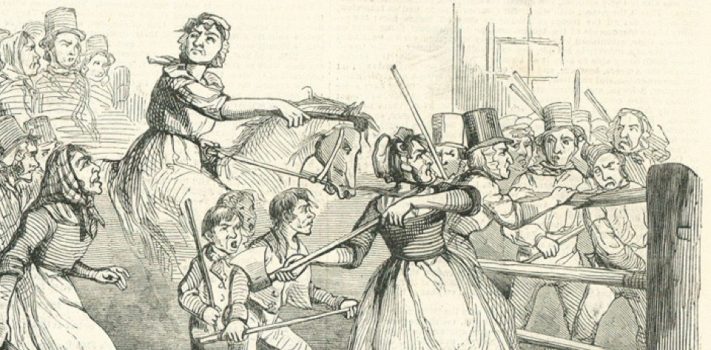“The [Biden] regime allows pure anarchy, zero consequences for its client populations, and the regime visits extreme tyranny on those it deems political enemies, namely law-abiding conservatives.” – Dr. Darren Beattie, Founder & Editor of Revolver News from an interview in the 2023 documentary film Police State, by Dinesh D’Souza
- Ad Click Here --> Civil Defense ManualNOW BACK IN STOCK How to protect, you, your family, friends and neighborhood in coming times of civil unrest… and much more!
- Ad Trekker Water Station 1Gal Per MinuteCall us if you have Questions 800-627-3809
Preparedness Notes for Sunday — November 19, 2023
Today is the anniversary of the Kyle Rittenhouse “Not Guilty” Verdicts, in 2021.
On this day in 1863, U.S. President Lincoln delivered the Gettysburg Address, at the dedication service for the National Cemetery in Pennsylvania.
And on November 19, 1703, The man in the iron mask, a political prisoner famous in French history and legend, died in the Bastille.
—
SurvivalBlog Writing Contest
Today we present another entry for Round 109 of the SurvivalBlog non-fiction writing contest. The prizes for this round include:
First Prize:
- The photovoltaic power specialists at Quantum Harvest LLC are providing a store-wide 10% off coupon. Depending on the model chosen, this could be worth more than $2000.
- A Gunsite Academy Three Day Course Certificate. This can be used for any of their one, two, or three-day course (a $1,095 value),
- Two cases of Mountain House freeze-dried assorted entrees in #10 cans, courtesy of Ready Made Resources (a $350 value),
- A $250 gift certificate good for any product from Sunflower Ammo,
- American Gunsmithing Institute (AGI) is providing a $300 certificate good towards any of their DVD training courses.
- Two sets of The Civil Defense Manual, (in two volumes) — a $193 value — kindly donated by the author, Jack Lawson.
Second Prize:
- A SIRT STIC AR-15/M4 Laser Training Package, courtesy of Next Level Training, that has a combined retail value of $679
- Two 1,000-foot spools of full mil-spec U.S.-made 750 paracord (in-stock colors only) from www.TOUGHGRID.com (a $240 value).
- Two Super Survival Pack seed collections, a $150 value, courtesy of Seed for Security, LLC.
- Montana Survival Seed is providing a $225 gift code for any items on its website, including organic non-GMO seeds, fossils, 1812-1964 US silver, jewelry, botany books, and Montana beeswax.
- A transferable $150 FRN purchase credit from Elk Creek Company, toward the purchase of any pre-1899 antique gun. There is no paperwork required for delivery of pre-1899 guns into most states, making them the last bastion of firearms purchasing privacy!
Third Prize:
- A $300 gift certificate from Good2Goco.com, good for any of their products: Home freeze dryers, pressure canners, Country Living grain mills, Emergency Essentials foods, and much more.
- Three sets each of made-in-USA regular and wide-mouth reusable canning lids. (This is a total of 300 lids and 600 gaskets.) This prize is courtesy of Harvest Guard (a $270 value)
- A Royal Berkey water filter, courtesy of Directive 21 (a $275 value),
- A transferable $150 FRN purchase credit from Elk Creek Company, toward the purchase of any pre-1899 antique gun.
—
More than $850,000 worth of prizes have been awarded since we started running this contest. We recently polled blog readers, asking for suggested article topics. Refer to that poll if you haven’t yet chosen an article topic. Round 109 ends on November 30th, so get busy writing and e-mail us your entry. Remember that there is a 1,500-word minimum, and that articles on practical “how-to” skills for survival have an advantage in the judging.
- Ad USA Berkey Water Filters - Start Drinking Purified Water Today!#1 Trusted Gravity Water Purification System! Start Drinking Purified Water now with a Berkey water filtration system. Find systems, replacement filters, parts and more here.
- Ad STRATEGIC RELOCATION REALTYFOR SALE: Self-sustaining Rural Property situated meticulously in serene locales distant from densely populated sanctuary cities. Remember…HISTORY Favors the PREPARED!
Alternative and Improvised Weapons – Part 6, by J.M.
(Continued from Part 5. This concludes the article.)
Fire
I’ve saved what will probably be the most controversial type of weapon for last – the use of fire for self-defense. Humans have an instinctual fear of fire, so you can harness that fear by adding fire-based weapons to your potential arsenal. There are a number of such options you should consider, but be aware that carrying pretty much any of these during ‘normal time will most likely get you in trouble with law enforcement.
- Molotov Cocktail – This is any breakable container filled with flammable liquid with a soaked wick sticking out – you light the wick, throw it and watch it break and burn. However, you first need to forget everything you’ve seen about them in the movies – modern glass bottles are designed not to break, so getting them to break on anything other than a hard surface like concrete or brick is very difficult. They can also be very dangerous to the person using them, since any gas spilled on your hands or clothing can catch you on fire. That being said, there may be scenarios where you can find smaller glass bottles you can fill with flammable liquid and store safely, which means without the wicks in them. However, in order to use them you’ll need to have the time to take them out, remove the cap or cover, stuff the wick in, allow the wick to soak up some fluid, then light them on fire and throw them onto a hard surface in front of or next to your attackers. A defense scenario with that amount of reaction time is probably not going to happen often enough to justify trying to carry them.
- Propane torch – A small propane torch that you find or buy can be an extremely effective way to deter an attacker. Try to find one with a trigger start so you don’t have to hold up a lighter to start it. There’s also going to be a short delay when deploying it since you’ll need to turn on the gas before you can light it.
- Flammable aerosol – You can do just like James Bond did and light the stream coming out of many types of aerosol cans such as deodorant, hairspray, WD-40, etc. Keep in mind that there are many ways this can go wrong and backfire on you, especially if you try to keep up a continuous stream for a long period of time.
- Flammable liquid – Fill a small plastic HDPE or aluminum squirt bottle with a flammable liquid like gasoline, lighter fluid, kerosene, etc., and when you’re attacked pull it out and squirt your attacker(s). Where you squirt them doesn’t matter, as long as they get some on them. Then light up your Zippo lighter and threaten to throw it at them if they don’t skedaddle. Note that a Bic-style lighter won’t work, since it will go out if you throw it. A 4oz. Zippo lighter fluid can also works well, since it’s designed to hold flammable liquid and it can squirt a decent distance.
- Torch – Wrap some 100% cotton material tightly around the end of a stick, soak it in flammable liquid and light it on fire. Swinging it in front of you will tend to keep most attackers at bay (human or otherwise). Keep in mind you’ll have many of the same issues as a Molotov cocktail – you’ll either have to carry something soaked in flammable liquid around with you, or hope an attacker will give you time to soak it and light it.
- Flare – Swinging a lit road flare in front of you will keep most attackers at bay, assuming you can keep them in front of you and you’ve got a backup plan for when the flare runs out. You can also use a flare gun to shoot flares at an attacker, although those are typically a lot harder to find than road flares. You can also break up road flares into smaller pieces and use a lighter to ignite them for a great fire starter.
Continue reading“Alternative and Improvised Weapons – Part 6, by J.M.”
- Ad Ready Made Resources, Trijicon Hunter Mk2$2000 off MSRP, Brand New in the case
- Ad LifeSaver 20K JerryCan Water PurifierThe best water jerrycan you can buy on the market! Mention Survivalblog for a Free Filter ($130 Value)
JWR’s Meme Of The Week:
The latest meme created by JWR:
Meme Text:
Joe Biden’s Secret Identity Has Been Revealed!
The Man Behind The Microphone’s Real Name is John Gill
News Links:
- Joe Biden Flubs NATO Speech in Teleprompter Fail.
- Joe Biden fumbles his way through Hanoi press conference.
- Joe Biden’s worst gaffes of all time.
- Two Minutes of Joe Biden Wandering Around Looking Lost.
Notes From JWR: Do you have a meme idea? Just e-mail me the concept, and I’ll try to assemble it. And if it is posted then I’ll give you credit. Thanks!
Permission to repost memes that I’ve created is granted, provided that credit to SurvivalBlog.com is included.
- Ad California Legal Rifles & Pistols!WBT makes all popular rifles compliant for your restrictive state. Choose from a wide range of top brands made compliant for your state.
- Ad USA Berkey Water Filters - Start Drinking Purified Water Today!#1 Trusted Gravity Water Purification System! Start Drinking Purified Water now with a Berkey water filtration system. Find systems, replacement filters, parts and more here.
The Editors’ Quote of the Day:
“Elect according to the foreknowledge of God the Father, through sanctification of the Spirit, unto obedience and sprinkling of the blood of Jesus Christ: Grace unto you, and peace, be multiplied.
Blessed be the God and Father of our Lord Jesus Christ, which according to his abundant mercy hath begotten us again unto a lively hope by the resurrection of Jesus Christ from the dead,
To an inheritance incorruptible, and undefiled, and that fadeth not away, reserved in heaven for you,
Who are kept by the power of God through faith unto salvation ready to be revealed in the last time.
Wherein ye greatly rejoice, though now for a season, if need be, ye are in heaviness through manifold temptations:
That the trial of your faith, being much more precious than of gold that perisheth, though it be tried with fire, might be found unto praise and honour and glory at the appearing of Jesus Christ:
Whom having not seen, ye love; in whom, though now ye see him not, yet believing, ye rejoice with joy unspeakable and full of glory:
Receiving the end of your faith, even the salvation of your souls.” – 1 Peter 1:2-9 (KJV)
- Ad Civil Defense ManualClick Here --> The Civil Defense Manual... The A to Z of survival. Looks what's in it... https://civildefensemanual.com/whats-in-the-civil-defense-manual/
- Ad Survival RealtyFind your secure and sustainable home. The leading marketplace for rural, remote, and off-grid properties worldwide. Affordable ads. No commissions are charged!
Preparedness Notes for Saturday — November 18, 2023
In 1952, Lieutenant Royce Williams was serving with VF-781 aboard the USS Oriskany as part of Task Force 77. From Wikipedia:
“On 18 November 1952, on his second mission of the day, while on combat air patrol near Hoeryong, North Korea, his group of four pilots spotted seven MiG-15s overhead. The other three pilots had to return to the carrier and the MiGs began to fire on Williams, putting him into a one-man dogfight with seven MiG-15s that lasted 35 minutes. It is believed to be the longest dogfight in U.S. Navy history. Commanders on his carrier ordered him away, but Williams had to tell them that he was already fighting for his life. He shot down four of the MiGs and likely hit two others. By the end of the 35-minute period, only one of the MiGs was still in the air with him, and he managed to escape back to his carrier, out of ammunition and having lost his hydraulics. He was uninjured, but 263 holes were counted in his Panther jet. He never saw the plane again; reportedly, it was pushed into the sea.”
On November 18, 1903, Philippe-Jean Bunau-Varilla, representing Panama, met with U.S. Secretary of State John Hay to negotiate the Hay–Bunau-Varilla Treaty, which gave the United States a strip 10 miles (16 km) wide across the Isthmus of Panama for construction of the Panama Canal.
—
SurvivalBlog Writing Contest
Today we present another entry for Round 109 of the SurvivalBlog non-fiction writing contest. The prizes for this round include:
First Prize:
- The photovoltaic power specialists at Quantum Harvest LLC are providing a store-wide 10% off coupon. Depending on the model chosen, this could be worth more than $2000.
- A Gunsite Academy Three Day Course Certificate. This can be used for any of their one, two, or three-day course (a $1,095 value),
- Two cases of Mountain House freeze-dried assorted entrees in #10 cans, courtesy of Ready Made Resources (a $350 value),
- A $250 gift certificate good for any product from Sunflower Ammo,
- American Gunsmithing Institute (AGI) is providing a $300 certificate good towards any of their DVD training courses.
- Two sets of The Civil Defense Manual, (in two volumes) — a $193 value — kindly donated by the author, Jack Lawson.
Second Prize:
- A SIRT STIC AR-15/M4 Laser Training Package, courtesy of Next Level Training, that has a combined retail value of $679
- Two 1,000-foot spools of full mil-spec U.S.-made 750 paracord (in-stock colors only) from www.TOUGHGRID.com (a $240 value).
- Two Super Survival Pack seed collections, a $150 value, courtesy of Seed for Security, LLC.
- Montana Survival Seed is providing a $225 gift code for any items on its website, including organic non-GMO seeds, fossils, 1812-1964 US silver, jewelry, botany books, and Montana beeswax.
- A transferable $150 FRN purchase credit from Elk Creek Company, toward the purchase of any pre-1899 antique gun. There is no paperwork required for delivery of pre-1899 guns into most states, making them the last bastion of firearms purchasing privacy!
Third Prize:
- A $300 gift certificate from Good2Goco.com, good for any of their products: Home freeze dryers, pressure canners, Country Living grain mills, Emergency Essentials foods, and much more.
- Three sets each of made-in-USA regular and wide-mouth reusable canning lids. (This is a total of 300 lids and 600 gaskets.) This prize is courtesy of Harvest Guard (a $270 value)
- A Royal Berkey water filter, courtesy of Directive 21 (a $275 value),
- A transferable $150 FRN purchase credit from Elk Creek Company, toward the purchase of any pre-1899 antique gun.
—
More than $850,000 worth of prizes have been awarded since we started running this contest. We recently polled blog readers, asking for suggested article topics. Refer to that poll if you haven’t yet chosen an article topic. Round 109 ends on November 30th, so get busy writing and e-mail us your entry. Remember that there is a 1,500-word minimum, and that articles on practical “how-to” skills for survival have an advantage in the judging.
- Ad Don't wait - get the ultimate US-made ultra-high performance US-made SIEGE Stoves and stunning hand-crafted SIEGE belts for Christmas. For stocking-stuffers see our amazing fire-starters. Gifts that can save lives. Big Sale!Every bespoke SIEGE buckle goes through an hours-long artisanal process resulting in a belt unlike anything else, with blazing fast performance and looks and comfort to match.
- Add Your Link Here
Alternative and Improvised Weapons – Part 5, by J.M.
(Continued from Part 4.)
Blunt Force Projectiles
Picking up something and throwing it at an attacker or game is another deep-seated instinct most people have, and it provides a number of additional options for weapons. A 9oz. projectile thrown at 45mph results in around 40 ft-lb of kinetic energy at impact, which is enough to break some smaller bones and cause a concussion. Throwing something accurately and hard enough to do damage requires a lot more practice than just swinging a club, but it can give you a stand-off capability to mitigate threats before they can get close to you.
As with clubs, there are a number of alternative and improvised options that you can leverage. One thing to keep in mind is that once you’ve thrown something there’s a chance you won’t be able to retrieve it, so you should plan on having multiple projectiles and/or alternate weapons options available. Some possible examples include:Continue reading“Alternative and Improvised Weapons – Part 5, by J.M.”
Editors’ Prepping Progress
To be prepared for a crisis, every Prepper must establish goals and make both long-term and short-term plans. In this column, the SurvivalBlog editors review their week’s prep activities and planned prep activities for the coming week. These range from healthcare and gear purchases to gardening, ranch improvements, bug-out bag fine-tuning, and food storage. This is something akin to our Retreat Owner Profiles, but written incrementally and in detail, throughout the year. We always welcome you to share your own successes and wisdom in your e-mailed letters. We post many of those –or excerpts thereof — in the Odds ‘n Sods Column or in the Snippets column. Let’s keep busy and be ready!
Jim Reports:
This has been a fairly quiet week. Early in the week, I slaughtered 10 of our young roosters. We had hatched those in our incubator. Since they were just five months old, it was fairly easy to skin them. As usual, Lily handled the final carcass cleanup, washing, bagging, and freezing. I already had a hole dug, to bury the legs, wing tips, heads, entrails, and pelts.
The three of us still here at the ranch all had our regular dental appointments, in rapid succession. Thankfully, our dental health has been stable for several years. We opt for check-ups and cleanings twice a year. I believe that is money well spent.
Now, Lily’s report…Continue reading“Editors’ Prepping Progress”
The Editors’ Quote of the Day:
“And it came to pass, when men began to multiply on the face of the earth, and daughters were born unto them,
That the sons of God saw the daughters of men that they were fair; and they took them wives of all which they chose.
And the Lord said, My spirit shall not always strive with man, for that he also is flesh: yet his days shall be an hundred and twenty years.
There were giants in the earth in those days; and also after that, when the sons of God came in unto the daughters of men, and they bare children to them, the same became mighty men which were of old, men of renown.
And God saw that the wickedness of man was great in the earth, and that every imagination of the thoughts of his heart was only evil continually.
And it repented the Lord that he had made man on the earth, and it grieved him at his heart.
And the Lord said, I will destroy man whom I have created from the face of the earth; both man, and beast, and the creeping thing, and the fowls of the air; for it repenteth me that I have made them.
But Noah found grace in the eyes of the Lord.” – Genesis:1-8 (KJV)
Preparedness Notes for Friday — November 17, 2023
On November 17, 1989, massive antigovernment demonstrations in Czechoslovakia were set off by police brutality at a demonstration commemorating the 50th anniversary of the suppression of a student demonstration in German-occupied Prague, and, under the leadership of Václav Havel, they continued until the communist government resigned. This became known as The Velvet Revolution.
—
On this day in 1777, the Articles of Confederation were submitted to the states for ratification. They differed from the Constitution in that they emphasized the primacy of the states.
—
After 10 years of construction, the Suez Canal opened in Egypt on November 17, 1869.
—
SurvivalBlog Writing Contest
Today we present another entry for Round 109 of the SurvivalBlog non-fiction writing contest. The prizes for this round include:
First Prize:
- The photovoltaic power specialists at Quantum Harvest LLC are providing a store-wide 10% off coupon. Depending on the model chosen, this could be worth more than $2000.
- A Gunsite Academy Three Day Course Certificate. This can be used for any of their one, two, or three-day course (a $1,095 value),
- Two cases of Mountain House freeze-dried assorted entrees in #10 cans, courtesy of Ready Made Resources (a $350 value),
- A $250 gift certificate good for any product from Sunflower Ammo,
- American Gunsmithing Institute (AGI) is providing a $300 certificate good towards any of their DVD training courses.
- Two sets of The Civil Defense Manual, (in two volumes) — a $193 value — kindly donated by the author, Jack Lawson.
Second Prize:
- A SIRT STIC AR-15/M4 Laser Training Package, courtesy of Next Level Training, that has a combined retail value of $679
- Two 1,000-foot spools of full mil-spec U.S.-made 750 paracord (in-stock colors only) from www.TOUGHGRID.com (a $240 value).
- Two Super Survival Pack seed collections, a $150 value, courtesy of Seed for Security, LLC.
- Montana Survival Seed is providing a $225 gift code for any items on its website, including organic non-GMO seeds, fossils, 1812-1964 US silver, jewelry, botany books, and Montana beeswax.
- A transferable $150 FRN purchase credit from Elk Creek Company, toward the purchase of any pre-1899 antique gun. There is no paperwork required for delivery of pre-1899 guns into most states, making them the last bastion of firearms purchasing privacy!
Third Prize:
- A $300 gift certificate from Good2Goco.com, good for any of their products: Home freeze dryers, pressure canners, Country Living grain mills, Emergency Essentials foods, and much more.
- Three sets each of made-in-USA regular and wide-mouth reusable canning lids. (This is a total of 300 lids and 600 gaskets.) This prize is courtesy of Harvest Guard (a $270 value)
- A Royal Berkey water filter, courtesy of Directive 21 (a $275 value),
- A transferable $150 FRN purchase credit from Elk Creek Company, toward the purchase of any pre-1899 antique gun.
—
More than $850,000 worth of prizes have been awarded since we started running this contest. We recently polled blog readers, asking for suggested article topics. Refer to that poll if you haven’t yet chosen an article topic. Round 109 ends on November 30th, so get busy writing and e-mail us your entry. Remember that there is a 1,500-word minimum, and that articles on practical “how-to” skills for survival have an advantage in the judging.
Alternative and Improvised Weapons – Part 4, by J.M.
(Continued from Part 3.)
Tasers and stun guns are another type of disruptive weapon, but regulations regarding possessing them tend to vary widely. Tasers are generally gun-like devices that shoot barbs on wires to deliver a high voltage to the target’s body, while stun guns require direct physical contact to deliver the voltage. I’m not crazy about any weapon that requires you to get close enough to an attacker to touch them, but it might be useful in some scenarios or as a last ditch option. A useful type of stun gun is the Stun Pen ($17), which doesn’t look like a traditional stun gun so it might mislead an attacker for several seconds. One potentially useful feature of stun guns is that if you push the button to activate them they make a very loud snapping/popping sound, which might deter a less-determined attacker. However, once you’ve done that you’ve given away the fact you’re carrying a stun gun, so a more determined attacker might just take action to disarm you.
Sound can also be used to disrupt an attack, but it’s generally only effective in limited circumstances, and it’s just as likely to impact you as it is an attacker unless you’re wearing hearing protection. Those small pull-pin personal alarms from companies like BASU, Resqume and others can put out 120db+ of sound, which is more than enough to temporarily disorient an attacker in a confined area and cause them to cover their ears. However, it won’t work as well in more open spaces, and even if you’re expecting it the sound can still cause you some discomfort.Continue reading“Alternative and Improvised Weapons – Part 4, by J.M.”
Economics & Investing For Preppers
Here are the latest news items and commentary on current economics news, market trends, stocks, investing opportunities, and the precious metals markets. In this column, JWR also covers hedges, derivatives, and various obscura. This column emphasizes JWR’s “tangibles heavy” investing strategy and contrarian perspective. Today, we look at the unfolding commercial real estate market collapse. (See the Tangibles Investing section.)
Precious Metals:
Key segments of the silver market to see 42% growth through 2033 – Oxford Economics.
o o o
It bears mentioning that spot and futures silver prices have recently started going through some larger price swings. Last Tuesday, spot silver jumped 3.45%. And then on Wednesday, it was up another 1.47% to $23.63 USD per Troy ounce. And then on Thursday, it was up another 1.19% to $23.98 USD per ounce. But I still consider silver a relative bargain — so stack it deep. But be sure to shop around to get the best price, since dealer premiums vary widely.
Economy & Finance:
Bank of America “Near Insolvent”? Bank Run Possible? (A hat tip to H.L. for the link.)
o o o
Is Social Security Safe? The CPI Changes Since the ’70s Are Raising Concerns.
o o o
Reader C.B. sent us this: New Biden ‘Joint Employer’ regulation is a boon for unions.
o o o
New USDA poultry rule slammed as ‘Bidenomics causing record inflation’.
o o o
‘Cashless Society’ Would Leave Millions Struggling. (A hat tip to D.S.V. for the link.)
The Editors’ Quote of the Day:
“The printing press is the greatest weapon in the armoury of the modern commander.” – T. E. Lawrence
Preparedness Notes for Thursday — November 16, 2023
On November 16, 1960, Actor Clark Gable, who epitomized the American ideal of masculinity for three decades and was known as the “King of Hollywood,” died of a heart attack, days after finishing work on The Misfits (1961).
—
November 16, 1632, Swedish King Gustav II Adolf died during the Battle of Lützen, though his forces were victorious; his cause was skillfully directed by his chief adviser, Axel Oxenstierna.
—
An Important Note: There are just three weeks before the December 7th, 2023 deadline for comments on ATF’s “Engaged in the business” rule. PLEASE politely post your objections to this unconstitutional rule. In your comment, make two points very clear: There is NO valid jurisdiction (“Federal Nexus”) for ATF to regulate private party INTRAState sales of used guns that are no longer in INTERstate commerce. Furthermore, per the Bruen decision, there is NO pre-1791 analogous gun law that anyone can cite. (Bruen‘s “History, text, and tradition.”)
—
SurvivalBlog Writing Contest
Today we present another entry for Round 109 of the SurvivalBlog non-fiction writing contest. The prizes for this round include:
First Prize:
- The photovoltaic power specialists at Quantum Harvest LLC are providing a store-wide 10% off coupon. Depending on the model chosen, this could be worth more than $2000.
- A Gunsite Academy Three Day Course Certificate. This can be used for any of their one, two, or three-day course (a $1,095 value),
- Two cases of Mountain House freeze-dried assorted entrees in #10 cans, courtesy of Ready Made Resources (a $350 value),
- A $250 gift certificate good for any product from Sunflower Ammo,
- American Gunsmithing Institute (AGI) is providing a $300 certificate good towards any of their DVD training courses.
- Two sets of The Civil Defense Manual, (in two volumes) — a $193 value — kindly donated by the author, Jack Lawson.
Second Prize:
- A SIRT STIC AR-15/M4 Laser Training Package, courtesy of Next Level Training, that has a combined retail value of $679
- Two 1,000-foot spools of full mil-spec U.S.-made 750 paracord (in-stock colors only) from www.TOUGHGRID.com (a $240 value).
- Two Super Survival Pack seed collections, a $150 value, courtesy of Seed for Security, LLC.
- Montana Survival Seed is providing a $225 gift code for any items on its website, including organic non-GMO seeds, fossils, 1812-1964 US silver, jewelry, botany books, and Montana beeswax.
- A transferable $150 FRN purchase credit from Elk Creek Company, toward the purchase of any pre-1899 antique gun. There is no paperwork required for delivery of pre-1899 guns into most states, making them the last bastion of firearms purchasing privacy!
Third Prize:
- A $300 gift certificate from Good2Goco.com, good for any of their products: Home freeze dryers, pressure canners, Country Living grain mills, Emergency Essentials foods, and much more.
- Three sets each of made-in-USA regular and wide-mouth reusable canning lids. (This is a total of 300 lids and 600 gaskets.) This prize is courtesy of Harvest Guard (a $270 value)
- A Royal Berkey water filter, courtesy of Directive 21 (a $275 value),
- A transferable $150 FRN purchase credit from Elk Creek Company, toward the purchase of any pre-1899 antique gun.
—
More than $850,000 worth of prizes have been awarded since we started running this contest. We recently polled blog readers, asking for suggested article topics. Refer to that poll if you haven’t yet chosen an article topic. Round 109 ends on November 30th, so get busy writing and e-mail us your entry. Remember that there is a 1,500-word minimum, and that articles on practical “how-to” skills for survival have an advantage in the judging.
Alternative and Improvised Weapons – Part 3, by J.M.
(Continued from Part 2.)
I’ve also got a smaller kit with just some very basic tools that fits in a wallet-size pouch (except for the Shomer-Tec saw) and weighs just 2.2oz, not including the .7oz trauma shears since I’m already carrying those in my FAK. It consists of:
- Wazoo tube wire saw w/1 extra titanium split ring (for handles)
- Shomer-Tec diamond bow saw
- Lever Gear Toolcard Pro (wrenches, cord cutter, additional screwdrivers, pry bar)
- Big Design Titanium Pocket Bits (I replaced the OEM split ring with a titanium one)
- Small 2” file from old multitool (on same split ring as driver bit)
- CRKT Micro Tool & Keychain Sharpener
- 4” trauma shears (in my medical kit)
Continue reading“Alternative and Improvised Weapons – Part 3, by J.M.”












